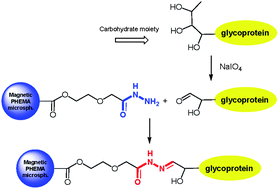Use of magnetic hydrazide-modified polymer microspheres for enrichment of Francisella tularensisglycoproteins
Abstract
The field of microbial proteomics has currently experienced a boom in the discovery of glycosylated

* Corresponding authors
a
Institute of Macromolecular Chemistry, Academy of Sciences of the Czech Republic, Heyrovský Sq. 2, Prague, Czech Republic
E-mail:
horak@imc.cas.cz
b Institute of Molecular Pathology, Faculty of Military Health Sciences, University of Defence, Třebešská 1575, Hradec Králové, Czech Republic
c Department of Chemistry, Indiana University, 800 E Kirkwood Avenue, Bloomington, IN, USA
The field of microbial proteomics has currently experienced a boom in the discovery of glycosylated

 Please wait while we load your content...
Something went wrong. Try again?
Please wait while we load your content...
Something went wrong. Try again?
D. Horák, L. Balonová, B. F. Mann, Z. Plichta, L. Hernychová, M. V. Novotny and J. Stulík, Soft Matter, 2012, 8, 2775 DOI: 10.1039/C2SM07036G
To request permission to reproduce material from this article, please go to the Copyright Clearance Center request page.
If you are an author contributing to an RSC publication, you do not need to request permission provided correct acknowledgement is given.
If you are the author of this article, you do not need to request permission to reproduce figures and diagrams provided correct acknowledgement is given. If you want to reproduce the whole article in a third-party publication (excluding your thesis/dissertation for which permission is not required) please go to the Copyright Clearance Center request page.
Read more about how to correctly acknowledge RSC content.
 Fetching data from CrossRef.
Fetching data from CrossRef.
This may take some time to load.
Loading related content
